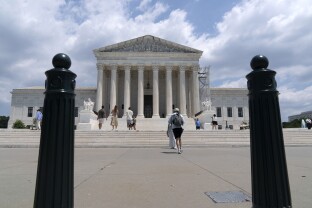The Supreme Court on Friday unexpectedly kicked the case looking at whether the Louisiana legislature relied improperly on race to create the state’s congressional district map to next term.
The decision to reargue the case came as a surprise, as the court was widely expected to come down with a ruling on the final day of the term. And it comes as a disappointment for Louisiana officials, who told NOTUS that they were looking forward to finality after a yearslong battle over their map.
“We were all hopeful that the Supreme Court would make its ruling today. I mean, that’s what everybody anticipated. But it’s in the court’s prerogative to do what it did,” Rep. Cleo Fields told NOTUS after the Supreme Court announcement.
Fields is the Democrat who represents the state’s second majority-Black district, which was created by the map. Fields noted that the facts of the case were not going to change, but said that he respected the court’s decision.
“At the end of the day, this is one that they have to get right,” Fields added. “They have to get it right. You cannot get it wrong. And I think they’re operating with all due caution to make sure they get it right.”
Justice Clarence Thomas dissented from the decision to have the case reargued.
“Congress requires this Court to exercise jurisdiction over constitutional challenges to congressional redistricting, and we accordingly have an obligation to resolve such challenges promptly,” Thomas wrote in his dissent.
The case revolves around a majority-Black congressional district, currently held by Fields, and tosses the future of the district in question. With the decision pending, lawmakers are left wondering if they need to craft a new map, a process which advocates worry could dilute minority voters’ say in next year’s midterms. Voting rights advocates have previously warned that this outcome would be a blow to the Voting Rights Act.
The map in question brought together an unusual pairing of Democratic and Republican backers.
Republican lawmakers in the state supported the map because of the way it protected several high-profile members of Congress politically. Democrats liked it because they saw it as an increased representation for Black voters and a new district friendly to Democrats.
“Well, it’s been up in the air one way or another for a couple of years now,” Rep. Clay Higgins, a Republican, told NOTUS before the ruling. “I mean, we just need resolution. We need final determination of what the law is going to require. And Louisiana has been attempting to comply with that for quite some time.”
The challenge to the congressional map was brought by 12 Louisiana voters who identify as “non-African American.” They argued that in creating the congressional map, which was used in the 2024 elections, the Louisiana legislature engaged in racial gerrymandering by ignoring “traditional redistricting criteria” in favor of maximizing “the voting strength of African American voters by stripping them from their communities in far-flung regions of Louisiana and consolidating them into two districts.”
Black Americans make up a third of Louisiana voters, and a court challenge brought by voting rights activists to an earlier version of the map successfully forced the state to create two majority-Black districts. The case had parallels to a similar one that played out in Alabama, which also resulted in a new majority-Black district there ahead of the 2024 elections.
Instead of continuing to litigate, the Louisiana legislature created the map at the heart of the Louisiana v. Callais case. State lawmakers decided to draw the map to avoid the potential of a federal court stepping in to do so — they worried that that alternative could end up forcing Republican lawmakers, including Speaker Mike Johnson, out of office, and that’s when the “non-African American voters” stepped in with their challenge in a separate court.
The Supreme Court ordered the state to keep the map with the added district in place for the 2024 election. This cleared the way for Fields to win the seat.
In oral arguments in March, several of the conservative justices on the court seemed to entertain the idea that the state’s recent congressional map relied too heavily on race. Justice Neil Gorsuch said that “politics played a role” in creating the district but questioned if race “predominated” the decision.
Chief Justice John Roberts questioned the assertion that the 6th Congressional District was “reasonably compact” and added that “it’s a snake that runs from one end of the district to the other. How is that compact?”
Michael McClanahan, president of the Louisiana NAACP State Conference, is among those hoping that the Supreme Court will ultimately leave the map in place.
“We have been fighting for fair maps in Louisiana for five years,” McClanahan said in a statement to NOTUS before Friday. “We hope that the Supreme Court will do the right thing and reject the argument that this map is a racial gerrymander. We are all watching this case closely and hope that Louisianans will have fair representation at the Congressional level after all these years.’”
—
Torrence Banks is a NOTUS reporter and an Allbritton Journalism Institute fellow.
Sign in
Log into your free account with your email. Don’t have one?
Check your email for a one-time code.
We sent a 4-digit code to . Enter the pin to confirm your account.
New code will be available in 1:00
Let’s try this again.
We encountered an error with the passcode sent to . Please reenter your email.


